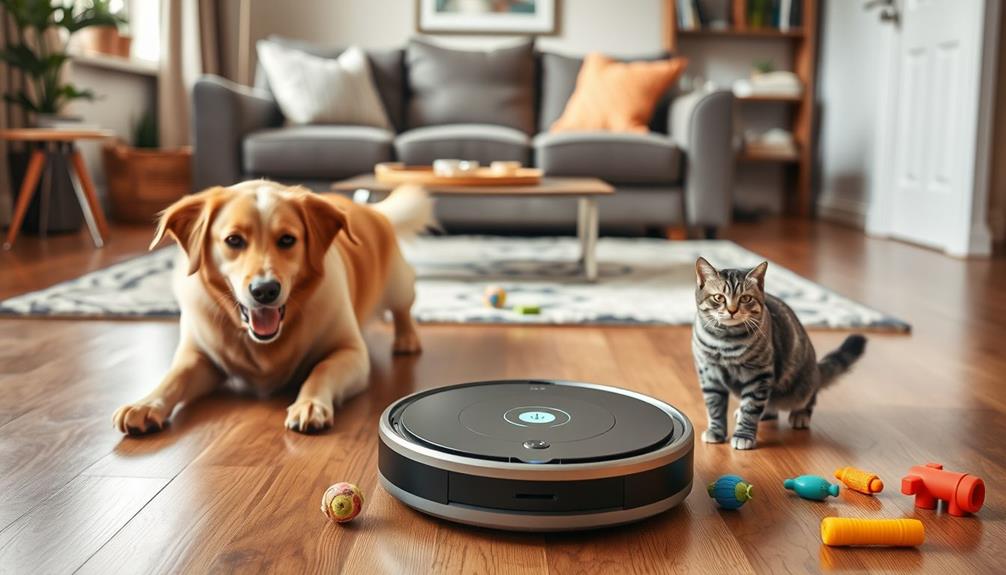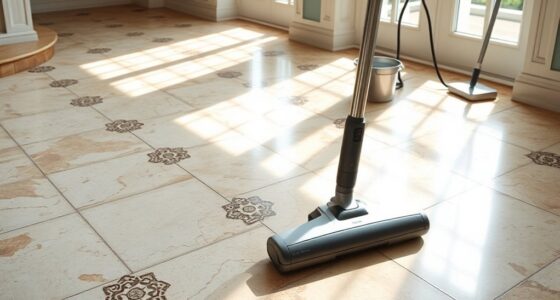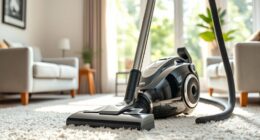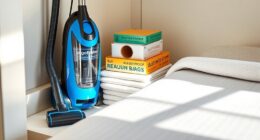Choosing the correct vacuum cleaner is crucial for effectively managing allergies. Be sure to opt for vacuums equipped with HEPA filters, as they can capture nearly all airborne allergens. Bagged models are also recommended since they can contain allergens better during disposal, making cleanup easier. Look for a vacuum with strong suction power and maneuverability for efficient cleaning. Additionally, consider the noise levels of the vacuum, as quieter models can make a significant difference. Proper maintenance, such as regularly changing filters and managing dust bins, is essential. By following these tips, you can significantly improve the air quality in your home. There are plenty of specific models and features to explore that can perfectly suit your needs.
Key Takeaways
- Choose vacuums with HEPA filters to effectively capture 99.97% of airborne allergens and improve indoor air quality.
- Opt for bagged models, as they better contain allergens during disposal compared to bagless options.
- Consider suction power and adjustable settings for deep cleaning various surfaces, especially carpets and upholstery.
- Regular maintenance, including filter replacement and dust bin management, is essential for optimal vacuum performance.
- Review consumer ratings and recommendations to assess effectiveness, reliability, and user satisfaction with different vacuum models.
Importance of HEPA Filters
When it comes to choosing a vacuum, understanding the importance of HEPA filters is essential for allergy sufferers. HEPA filters are specifically designed to capture 99.97% of airborne particles as small as 0.3 microns, effectively trapping common allergens like dust, pollen, and pet dander. This level of filtration is particularly vital if you struggle with allergies or asthma, as it helps improve your indoor air quality.
Many of the best value vacuum cleaners come equipped with HEPA filters, ensuring effective allergen reduction while maintaining affordability.
The United States Environmental Protection Agency emphasizes that effective air filtration can greatly reduce allergens in your home. When selecting vacuum cleaners, look for models equipped with sealed systems that incorporate HEPA filters, ensuring that allergens stay trapped and aren't released back into the air during operation or disposal.
It's also important to remember that regular maintenance plays a key role in the effectiveness of HEPA filters. Most manufacturers recommend replacing these filters every 6 to 12 months.
To guarantee you're getting a quality vacuum, consider options certified by the Asthma and Allergy Foundation of America, which meet strict performance standards for allergen reduction. Prioritize your health by choosing vacuum cleaners with HEPA filtration.
Types of Vacuums for Allergies

When choosing a vacuum for allergies, you'll want to take into account both bagged and bagless options.
Bagged vacuums generally trap allergens better, while bagless models can release particles back into the air if not designed properly.
For pet owners, vacuums like the Bissell Pet Hair Eraser Vacuum feature technology that enhances suction power and reduces maintenance.
Additionally, make sure any vacuum you choose has a HEPA filter to effectively capture allergens.
Bagged Vs. Bagless Options
Choosing between bagged and bagless vacuums can greatly impact your allergy management. If you're an allergy sufferer, a bagged vacuum might be your best bet. These vacuums typically contain dust and allergens within sealed bags, minimizing the risk of particles escaping back into the air during disposal.
Many bagged models come equipped with HEPA filters, which can trap 99.97% of particles as small as 0.3 microns, making them highly effective for cleaning carpets and reducing allergens in your home. Additionally, using an air purifier alongside your vacuum can further enhance your indoor air quality by eliminating allergens and harmful particles that can contribute to allergies.
On the other hand, bagless vacuums offer the convenience of not needing bag replacements, but they can release dust clouds when emptied. This could aggravate your allergy symptoms if the vacuum isn't designed for containment.
Maintenance is essential for bagless models; clogged filters can lead to diminished suction power and increased allergen emissions. In contrast, bagged vacuums usually require less frequent maintenance related to dust exposure.
Allergists often recommend bagged vacuums for individuals with severe allergies due to their superior ability to securely trap and contain allergens, making them a safer choice for minimizing exposure during cleaning.
Importance of HEPA Filters
HEPA filters are fundamental for those dealing with allergies, as they capture 99.97% of airborne particles as small as 0.3 microns. This means they effectively trap allergens like dust, pollen, and pet dander, making them essential for your vacuum's filtration system.
When choosing vacuum models, look for those equipped with a sealed HEPA system. This design prevents allergens from escaping back into the air during cleaning, greatly improving your indoor air quality. Additionally, understanding keyword strategy and SEO optimization can help in selecting vacuums that are highly rated for allergen removal.
Both bagged and bagless vacuums can feature HEPA filters, but bagged vacuums generally offer better containment of dust and debris during disposal. This added layer of protection is especially beneficial for allergy sufferers.
Remember, regular maintenance is critical; replacing or washing HEPA filters guarantees they continue to work effectively in removing allergens.
The Asthma and Allergy Foundation of America (AAFA) certifies vacuums with efficient HEPA filtration, indicating they meet stringent standards for allergen reduction.
Key Features to Consider

To effectively combat allergens in your home, it's important to focus on specific features in a vacuum. First, prioritize a HEPA vacuum. These filters capture 99.97% of airborne particles down to 0.3 microns, efficiently reducing allergens like dust, pollen, and pet dander.
Additionally, implementing a methodical approach in your cleaning routine can guarantee consistent allergen removal, much like the best practices in software quality assurance that emphasize thoroughness and reliability.
Next, consider bagged models. They generally contain allergens better during disposal compared to bagless options, which can release dust back into the air when emptied.
Sealed systems are another critical feature. They prevent allergens from escaping, guaranteeing cleaner air emissions during and after use. This is fundamental for maintaining a healthy environment, especially for allergy sufferers.
You should also evaluate maneuverability and cleaning capabilities. A vacuum that performs well on both carpets and hard floors is important for thorough allergen removal. Look for models that glide easily and can reach tight spaces, making your cleaning routine more effective.
Lastly, research reliability and owner satisfaction ratings. Choosing a dependable vacuum guarantees you have an effective tool for long-term allergy management, allowing you to breathe easier in your home.
Top Bagged Vacuums

When it comes to selecting bagged vacuums for allergy sufferers, several standout options can greatly enhance your cleaning routine. It's crucial to evaluate vacuums that not only remove allergens effectively but also guarantee a healthier home environment.
The Kenmore Elite Pet Friendly 31150 is perfect for pet owners, boasting clean emissions and excellent pet-hair pickup. Its brush on/off switch allows you to customize your cleaning for different surfaces, making it versatile for allergy sufferers.
Another great choice is the Kenmore BU1018, which effectively removes pet hair and allergens from both carpets and bare floors, thanks to its HEPA filter that provides superior filtration.
If you're looking for a bagged canister, contemplate the Kenmore Elite Pet Friendly CrossOver 21814. This model offers superb suction and clean emissions, though it weighs in at 26 pounds.
For those prioritizing quiet operation and exceptional filtration, the Miele Complete C3 Marin combines performance and reliability, making it a top contender for allergy sufferers to learn more about what to look for in a home cleaning service.
Finally, if budget isn't a concern, the Kirby Avalir 2 delivers high carpet cleaning capability but lacks a HEPA filter, which might impact allergy management.
Choose wisely based on your specific needs!
Top Bagless Vacuums

When you're considering a bagless vacuum, you'll want to pay attention to effective filtration systems that capture allergens and improve your home's air quality.
Incorporating strategies like balanced nutrition can also enhance overall well-being, which is essential for allergy sufferers.
Maneuverability and design also play a key role in how easily you can clean different surfaces.
Plus, regular maintenance is essential to keep your vacuum running efficiently and to minimize allergy triggers.
Effective Filtration Systems
Selecting a bagless vacuum with an effective filtration system can make a considerable difference for allergy sufferers. You'll want to focus on models that feature sealed HEPA filtration, which prevents dust and allergens from being released back into the air during operation.
These high-efficiency particulate air (HEPA) filters are designed to capture up to 99.97% of particles as small as 0.3 microns, guaranteeing cleaner air while you're cleaning. Additionally, investing in safety glasses can protect your eyes from allergens kicked up during the vacuuming process.
For instance, the Shark NV360 Navigator Lift-Away Deluxe is well-regarded for its sealed HEPA filter, effectively tackling allergens across various surfaces. Similarly, the Tineco Pure One S11 boasts a sealed four-stage filtration system that traps dust and allergens while automatically adjusting suction power for peak cleaning.
The Dyson V11 Torque Drive further enhances allergy management, capturing nearly all particles.
Regular maintenance of your vacuum's filters is essential. Timely replacement of filters guarantees your vacuum operates at peak efficiency, maintaining clean emissions.
Investing in a bagless vacuum with an effective filtration system not only simplifies cleaning but also greatly improves your indoor air quality, making it a wise choice for allergy sufferers.
Maneuverability and Design
A bagless vacuum's effective filtration system is just one part of the equation. You also need to take into account the vacuum's maneuverability and design, especially if you're dealing with allergens in your home. An upright model like the Dyson Ball Animal 3 Extra offers exceptional navigation around corners and under furniture, making it easy to maintain a thorough cleaning regimen.
Similarly, the Tineco Pure One S11 features a lightweight design that enhances maneuverability, allowing you to clean bare floors and tight spaces effortlessly. Plus, many bagless vacuums include a sealed HEPA filtration system, which captures allergens and improves indoor air quality.
Here's a quick comparison of some top bagless vacuums:
| Vacuum Model | Maneuverability | Filtration Type |
|---|---|---|
| Shark NV360 Navigator | Good | Sealed HEPA |
| Dyson V11 Torque Drive | Excellent | Sealed HEPA |
| Tineco Pure One S11 | Very Good | Advanced HEPA |
| Dyson Ball Animal 3 Extra | Outstanding | Sealed HEPA |
Choosing the right design will guarantee you can easily tackle allergens and keep your home clean.
Maintenance and Care
Maintaining your bagless vacuum is essential for keeping allergens at bay and ensuring peak performance. Regularly clean and replace the filters in your vacuum cleaner; clogged filters can reduce suction power and increase the emission of airborne particles.
Just like how essential oils can enhance mood, a well-maintained vacuum can create a more pleasant indoor environment. Make it a habit to empty the dust bin after each use. A simple, dust-free emptying process can minimize your exposure to allergens during disposal.
Consider opting for bagless vacuums with a sealed system, which guarantees that dust and allergens stay contained during operation and emptying, enhancing your indoor air quality.
Don't forget to inspect and clean the brush rolls regularly to prevent hair and debris buildup, which can obstruct airflow and diminish cleaning performance.
Lastly, always follow the manufacturer's maintenance guidelines. This includes periodic checks for wear on hoses and attachments, ensuring that your vacuum operates at peak efficiency for effective allergy management.
Testing Methodology

When it comes to choosing a vacuum that truly meets the needs of allergy sufferers, understanding the testing methodology is essential.
Consumer Reports conducts extensive lab tests on over 300 vacuums to assess their performance in removing debris from both carpets and clean floors. The testing methodology involves measuring airflow with various weights of wood flour, which helps evaluate suction power and overall performance.
Additionally, selecting a vacuum with a HEPA filter can greatly reduce airborne allergens, contributing to a healthier home environment, especially for those managing menopause symptoms.
Maneuverability is another vital factor; they examine how easily vacuums can navigate around and under furniture. This is particularly important for allergy sufferers who need to reach every corner of their home.
Emissions testing is performed using a laser spectrometer to analyze the amount of airborne particles released during vacuuming, ensuring that the vacuums meet clean emissions standards. This is essential for minimizing allergens in your environment.
User Experience Insights

Understanding the testing methodology provides a solid foundation, but real-world user experiences often highlight what it's like to live with these vacuums. Many users appreciate the ease of use of models like the Shark NV360, which excels in emptying dustbins and cleaning both carpets and hard floors effectively.
However, high-pile carpets can pose a challenge for some. Heavier vacuums, such as the Kenmore Elite, offer powerful pet-friendly tools but may be cumbersome for everyday use.
Real-time feedback is another feature that enhances user experience, particularly with the Tineco Pure One S11, which includes an LED display.
However, users report it may struggle with larger debris on hard floors. When it comes to battery life, the Dyson V11 Torque Drive provides impressive suction but varies considerably depending on the mode you choose.
Lastly, noise levels can be essential for those sensitive to sound. The Miele Complete C3 stands out for its quiet operation while maintaining excellent HEPA filtration and suction.
These insights can guide you in selecting the best vacuums for allergies that fit your lifestyle and needs. When considering vacuum selection for elderly users, it’s important to factor in their physical limitations and mobility. Look for lightweight and easy-to-maneuver models with adjustable handles and minimal maintenance requirements. Additionally, consider features such as easy-to-empty debris canisters and HEPA filtration systems to ensure a cleaner and healthier living environment for those with allergies.
Shopping Tips and Resources

Finding the right vacuum for allergy relief can be overwhelming, but focusing on a few key features can simplify your search. Start by prioritizing vacuums that include HEPA filters, as these capture 99.97% of airborne allergens like pollen, dust, and pet dander. This greatly enhances your indoor air quality.
Consider opting for a bagged vacuum; these models usually contain allergens better than bagless options, preventing dust from escaping during disposal. Additionally, check for certifications from the Asthma and Allergy Foundation of America (AAFA). Vacuums with this certification meet strict standards for allergen reduction.
Evaluate the cleaning performance on various surfaces, from carpets to hard floors, and pay attention to maneuverability. A vacuum that's easy to handle will make your cleaning routine much more efficient.
Lastly, don't forget to consult resources like Consumer Reports for in-depth ratings and reviews. Focus on emissions, reliability, and owner satisfaction to find the best vacuum for your needs. By following these shopping tips, you're more likely to choose a vacuum that effectively addresses your allergy concerns.
Frequently Asked Questions
What Type of Vacuum Is Best for Allergies?
When you're searching for the best vacuum for allergies, focus on models with HEPA filters. They capture nearly all airborne allergens, improving your air quality.
Consider bagged vacuums, as they trap dust securely during disposal, unlike bagless ones that can release particles.
Additionally, look for sealed systems to keep allergens contained.
Does a HEPA Vacuum Help With Allergies?
When you've got sniffles and sneezes, a HEPA vacuum can feel like a refreshing change.
It captures nearly all airborne nasties, including pesky dust and pet dander, which helps keep your space comfortable.
With its sealed filtration system, you won't have to worry about allergens sneaking back into your home.
Just remember to keep those filters clean or replaced, so you can keep enjoying a healthier living environment.
Are Bagless Vacuums Better for Allergies?
When considering if bagless vacuums are better for allergies, it's important to look at their filtration systems.
Many bagless models feature sealed HEPA filters that trap 99.97% of airborne allergens. They can be just as effective as bagged vacuums, but you've gotta be careful when emptying the dustbin to avoid dust clouds.
Regular maintenance is key to ensuring they perform well in reducing allergens, so keep those filters and containers clean!
How to Vacuum When You Have Allergies?
When you vacuum with allergies, start by choosing a vacuum with a HEPA filter to trap allergens effectively.
Make sure to vacuum at least once a week, or more often if you've got pets.
Use a bagged vacuum to minimize dust clouds during disposal.
Don't forget to employ specialized attachments for upholstery and tight spaces, as allergens often hide there.
Conclusion
So, you thought all vacuums were created equal? Think again! Choosing the right vacuum for allergy sufferers isn't just about suction power; it's about keeping your home's air clean. With HEPA filters, bagged options, and the right features, you can breathe easier. Don't just settle for the shiny model that looks good in the store. Remember, the best vacuum isn't the one that looks pretty; it's the one that helps you kick allergens to the curb!









